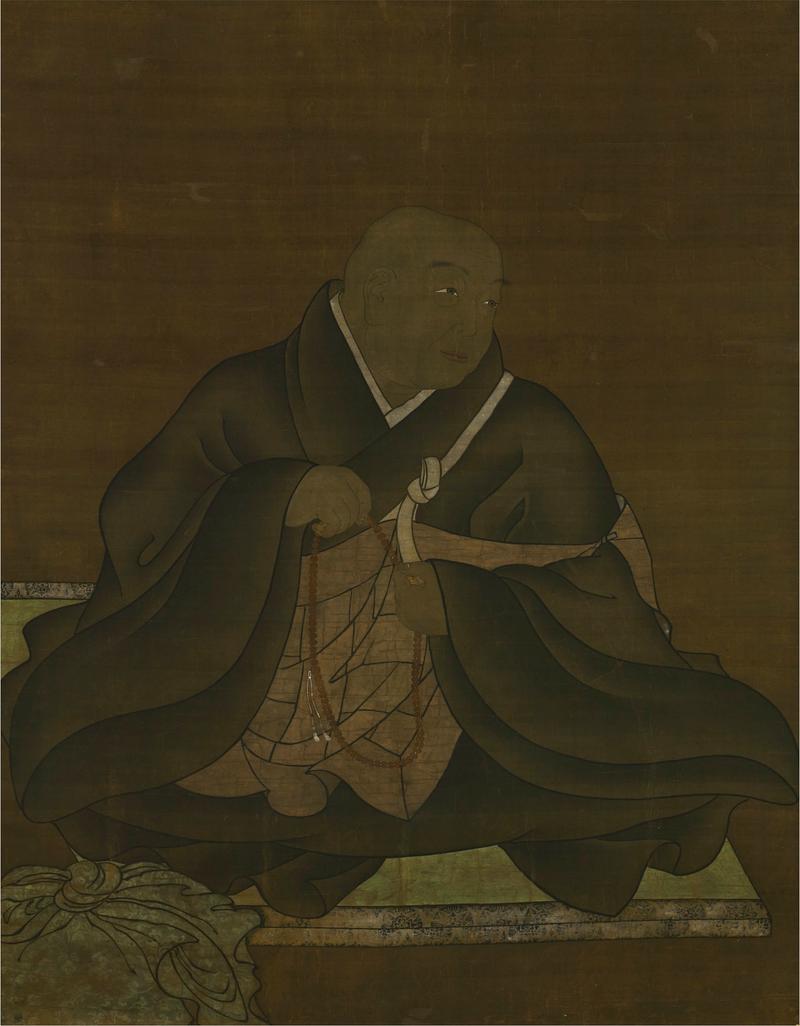A kakemono (hanging scroll) painted in ink and colour on silk with a portrait of the monk Hōnen.
Japan, 15th/16th century, Muromachi/Momoyama period.
Dimensions:
Scroll: H. 205.5cm x W. 107.5cm (81" x 42½")
Painting: H. 108cm x W. 84cm (42¾" x 33¼")
Hōnen (1133-1212) is the religious reformer and founder of the first independent branch of Japanese Pure Land Buddhism called Jōdo shū (The Pure Land School). In the related Jōdo Shinshū sect, he is considered the Seventh Patriarch. Following his father’s last wish, Hōnen became a monk of the Tendai sect at an early age, but grew disaffected and sought an approach to Buddhism that anyone could follow. Whilst studying at Mount Hiei he discovered the writings of Shan-tao, the Chinese Pure Land master who first undertook the teaching of rebirth in the Pure Land of Amitabha through nembutsu (reciting Buddha's name).
‘Only repeat the name of Amitabha with all your heart. Whether walking or standing, sitting or lying, never cease the practice of it even for a moment. This is the very work which unfailingly issues salvation, for it is in accordance with the Original Vow of Buddha.’
This commentary persuaded Hōnen to believe that nembutsu was all one needed to enter Amida Buddha’s Pure land. This new appreciation and understanding prompted him to leave Mount Hiei and the Tendai tradition in 1175.
Hōnen relocated to the district of Ōtani in Kyoto where he started addressing crowds of men and women, establishing a considerable following. He attracted fortune-tellers, ex-robbers, samurai and other elements of society normally excluded from Buddhist practice. Hōnen was a man of recognition in Kyoto and many priests and noblemen allied with him and visited him for spiritual advice. The increasing popularity of his teachings drew criticism from noted contemporaries who argued against Hōnen's sole reliance on nembutsu as a means of rebirth in the Pure Land.
The single practice of nembutsu denied the usefulness of all other Buddhist practices irking other sects. The sole emphasis on Amida Buddha was also coupled with discouraging the traditional worship of the kami (Shinto gods). Furthermore Hōnen placed the lowest lay-person on equal footing with the wisest monk, rendering the entire monastic establishment as useless again raising the ire of other sects. This undermining of those in power led the Emperor to exile him and his followers in 1207.
This exile prompted the following quote:
‘I have laboured here in the capital these many years for the spread of nembutsu, and so I have long wished to get away into the country to preach to those on field and plain, but the time never came for the fulfilment of my wish. Now, however, by the august favour of His Majesty, circumstances have combined to enable me to do so.’
While in exile, Hōnen spread the teachings to the people he met including fishermen, prostitutes and the peasantry. In 1211 the nembutsu ban was ultimately lifted and Hōnen was permitted to return to Kyoto where he stayed for a short time before his death.
For a similar portrait of Hōnen in the collection of Konkaikomyo-ji, Kyoto see: The Heibonsha Survey of Japanese Art, Volume 11, Sculpture of the Kamakura period by Hisashi Mori, 1974, p.124, pl.125 and for a standing image in the collection of Jūrin-ji, Hyogo, featured in the special 800th Memorial Exhibition at Nara National Museum and Kanagawa Prefectural Kanazawa-Bunko Museum see: Jōkei, A Monk at the Heart of Kamakura-era Buddhism, 2012, p.93, pl.63.














